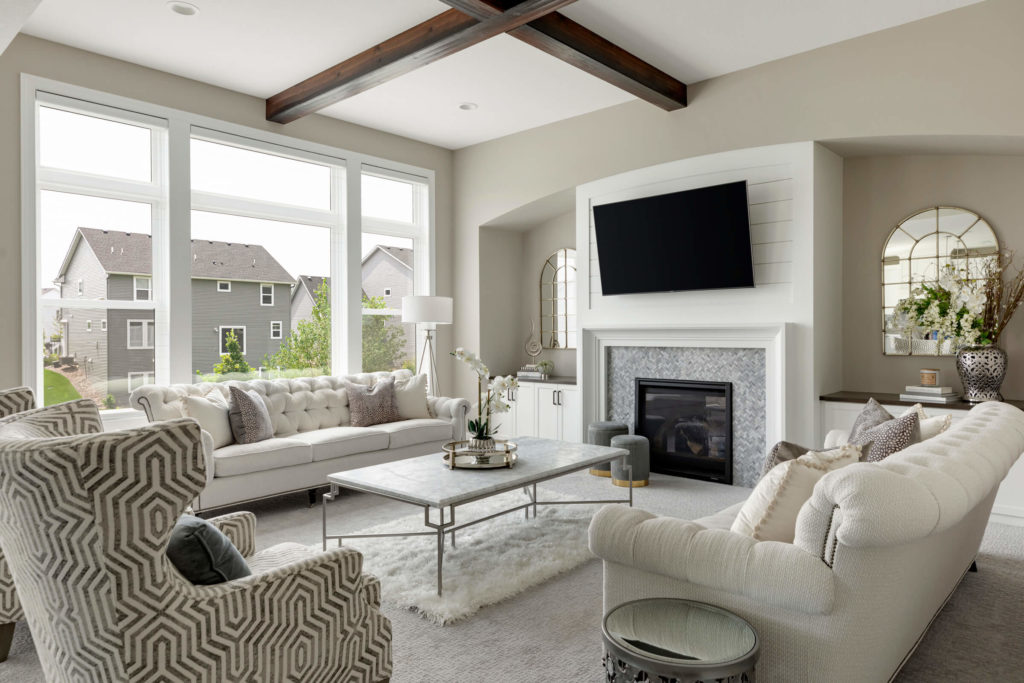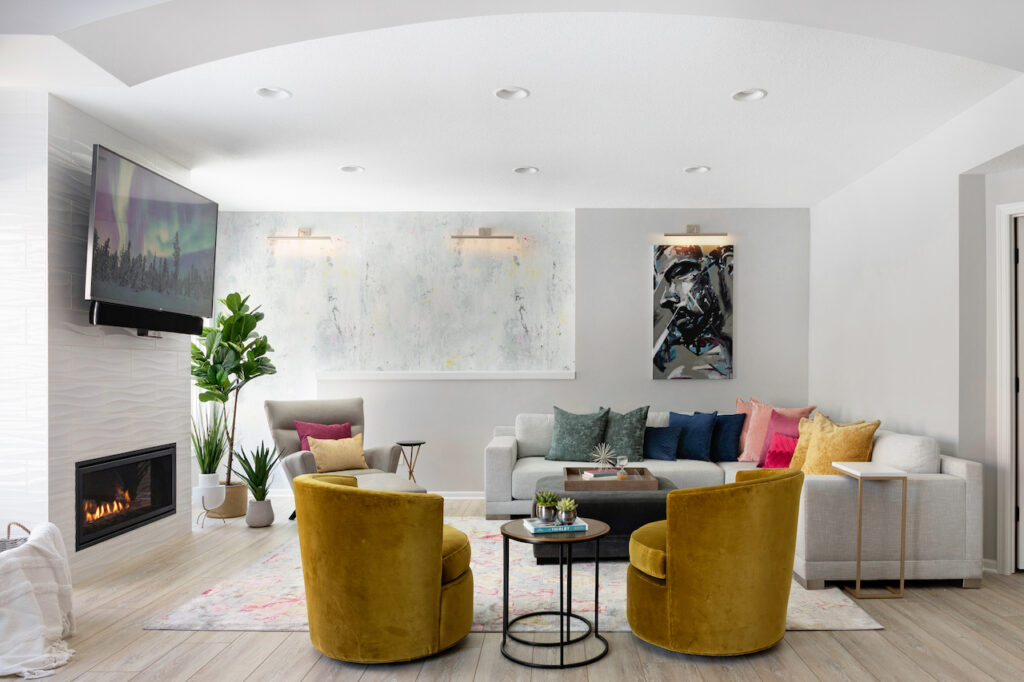Top Living Room Interior Design Ideas
A commonly heard adage insists that the “kitchen is the heart of the home.” While this may be true, the living room gives the kitchen some serious competition.
These multipurpose spaces have the potential to serve many benefits, including everything from providing a quiet place for relaxation and restoration to serving as a gathering hub for family and friends. As such, the best living rooms are mindfully designed to accommodate the breadth and depth of activities they play host to.
However, they must also do something else: provide a warm and welcoming environment through it all.
Whether you’re designing a living room from scratch as part of a new home build project or undertaking a living room remodel or renovation, you’ve got many options. Here, you’ll find information, ideas, and inspiration to guide your living room design project.
Selecting a Living Room Design Style
Understanding the various interior design styles can help you identify the one that best resonates with your functional and aesthetic goals.
Here’s a closer look at eight popular design styles:
1. Modern
Is “clutter” one of your least favorite words? If so, this interior design style—which leads with simplicity—may be a pleasing pick for your living room.
While the name may indicate otherwise, this popular style emerged in the 1950s and 1960s as a response to the formality and conventions of previous decades. Its motto? “Form follows function.”
Prizing functionality above all else, modern design draws inspiration from German and Scandinavian design. It embraces clean lines and curves, white walls, neutral tones and textures (monochrome is common), natural and sustainable materials, open flowing spaces with abundant natural light, and natural materials and elements.
2. Rustic
Mention the word “rustic” and thoughts immediately turn to log cabins. However, this design style isn’t just popular on the prairie. Emphasizing the use of natural, aged, and organic materials in their most natural states, this relaxed style is approachable, lived-in, rugged, and imperfect.
Key features found in rustic design include the use of real wood (exposed beams are big), textural variety, unique and handmade items, and “heavy” furniture and other homey elements.
Prefer the unfinished look of raw driftwood to polished-to-perfection burl wood? If so, a rusting living room may be right for you.
3. Eclectic
Bringing different design styles and motifs together, eclectic design is dynamic, lively, and entirely individualistic. Love traditional design, but want something more unique? Have a boho spirit, but yearn for a touch of glitz and glam? Eclectic design’s mix-and-match approach means you don’t have to choose.
Common characteristics of this diverse decorating style include mixing prints, patterns, textures and other visual elements, fusing decor from different time periods, and careful curation to achieve an effortless yet cohesive end result.
4. Bohemian
“Boho” for short, this versatile design style is individual, free-spirited, and eclectic. It draws influence from the natural world and our experiences in it.
Bohemian design takes a carefree approach to color, pattern, and textures— all anchored by comfort and meaning. Organic elements are also an integral part of the boho aesthetic, and plants, greenery, and nature-inspired motifs are often front and center.
Other characteristics of boho design include natural materials like rattan, wicker, macrame, and carved wood; mix-and-match and layered textiles (think cozy blankets, pillows, throws, poufs, floor cushions, and rugs); vibrant colors; and global influences.
5. Industrial
Born in the 1960s, this stripped-back style continues to thrive today. Blending the minimalist design philosophy with rustic factory inspiration, one of its most distinctive components is the use of brick, concrete, metal, and wood and other rough or classic industrial materials—often reclaimed or restored for extra charm and authenticity.
Other characteristics of industrial interior design include a neutral color palette, large windows and natural light, bold architectural features such as visible ductwork and industrial pipes, bare light bulbs, and graphic lines. Natural textiles like linen and weathered leather add warmth and coziness.
In addition to being found in warehouses and lofts, this inventive style is especially suitable for contemporary homes with open floor plans. It’s also often fused with farmhouse and mid-century modern styles for a contemporary look.
6. Traditional
If you’re more traditional than trendy, this sophisticated style may speak to you. Rather than following current trends, the traditional design style calls on classic design concepts dating back to 18th and 19th century Europe.
A few hallmarks of this upscale approach? Warm tones and colors, classic art, symmetry, upholstered antique furniture, and architectural details like decorative doors, ceiling medallions, and ornate fireplaces.
And while there is a degree of formality associated with traditional design, it’s not fussy, fancy, or overwrought.
7. Glam
If you love all things lux, a glam approach may help you achieve your ideal show-stopping space. Offering the airy, upscale, and opulent feel of old Hollywood, glam strikes a beautiful blend between elegance and extravagance. Take the traditional decorating style and give it a blinged-out makeover, and you’ve got glam.
Looking to take your living space from bland to glam? Key elements of this feminine decorating style include dramatic lighting, gold accents and mixed metals, statement-making furniture, polished surfaces, Art Deco influences, and bold patterns like damask and geometric designs.
Note that there are varying degrees of glam ranging from full-on ostentatiousness to more subtle nods in its dazzling direction.

==>>Note that Glam doesn’t have to be over the top. Incorporating subtle touches, like those pictured in this Lake Elmo, MN new construction selections project, can add just the right level of luxe.
8. Minimalist
Minimalist design overlaps with modern design in many ways, including through the integration of clean lines, neutral color palettes, functional furniture, and natural lighting. However, while modern design may lead with simplicity, minimalism maintains purpose as its overarching goal.
One of the 20th century’s most significant design movements, this style rejects the lavish for extreme spareness. Its hallmarks include monochromatic color schemes, uncomplicated wall coverings and finishes, open and light-filled spaces, and an essentials-only aesthetic.
If you need your creature comforts, minimalism may miss the mark for you. However, if you’re intrigued by the concept of a complexity-free environment, a minimalist living room may offer the calm you crave.
Choose a Color Palette
Color is a powerful interior design tool. For living rooms, color can be especially important—both in terms of how the space looks and feels. It can be used to make a small space feel bigger, make a low ceiling feel like a high ceiling, to evoke intimacy, engagement, or other emotions, and to highlight certain architectural details.
Are you looking for a relaxing retreat or an invigorating gathering place? Color can be used to achieve both of these outcomes—if you choose wisely. For example, while, light colors are airy, expansive, and can make a room seem larger, while dark colors offer sophistication, warmth, and an intimate feel.
- Bright Colors. Bright hues like yellows, reds, bright blues, and greens add cheer and life to a space but can also be overwhelming if not in balance.
- Neutral Tones. Neutral hues often get a bad rap as boring, but can be versatile, calm, and relaxing with the right approach.
- Cool Colors. Comprising any hue with blue undertones, including blues, greens and purples, cool colors are known for having a calming effect.
- Warm Colors. Comprising reds, oranges, and yellows, warm colors can make a room feel anything from cozy to stimulating.
- Contrasting Colors. Contrasting colors can be used together to complement and balance each other.
One note on color? While starting with colors you love is a big part of the color selection process, it’s also important to consider other factors, such as color theory and color psychology. A color consultant can offer invaluable partnership in selecting the best colors for your living room and other spaces within your home.
Living Room Furniture
Have you ever walked into a living room that felt instantly inviting and comfortable—like you could stay there forever happily? Many factors go into achieving this outcome, including design style and color scheme. However, furniture is also a huge part of that equation.
Deep seating is having a major moment, and with good reason. Deep upholstery sofas, sectional sofas, and chairs are comfortable and attractive. Additional must-have furniture pieces for living rooms include ottomans, coffee tables, occasional and side tables, and storage, such as entertainment centers and shelving.
Designing a welcoming and functional living room isn’t just about having the right furniture, however. It’s also about the layout of that furniture. Other factors include choosing a focal point, creating conversation areas through thoughtful seating arrangements, seeking balance, considering traffic flow, putting tables at arm’s length, using the right-sized rugs, adding in artwork and other decorative elements, and incorporating ample lighting.
Pulling this all together can be complex, which is why many people choose to enlist the guidance of interior design professionals like Che Bella Interiors.
Consider an Accent Wall
Interior designers have many go-to strategies and tricks for turning ordinary spaces into extraordinary ones. Accent walls are an effective way to enhance a room without significant effort or expense. Whether you’re hoping to create visual interest in your living room, foster fluidity throughout your home, or highlight an interesting design element, an accent wall can help you achieve these objectives.
Love a particular color, but don’t love the idea of it on all four walls? An accent wall delivers here, too. It lets you make a dramatic statement without overtaking the space.
And accent walls aren’t limited to paint color. A single brick wall or wallpaper accent wall can make a unique, eye-catching addition to your design.

==>> See more photos of this Savage, MN basement remodel featuring bold colors paired with a neutral color palette and a wall-papered accent wall.
Determine a Focal Point
Earlier, we mentioned the task of pulling a room together. Selecting a focal point from the beginning is vital to achieving this objective.
A focal point is the “thing” in the room that draws people’s gaze. It can be an “organic” element, such as a window, fireplace, or other architectural feature. Alternatively, a focal point can be created with accent walls, artwork, statement furniture, or a dramatic light fixture, such as a chandelier or pendant light.
When planning your living room’s design, defining its focal point should be a paramount consideration. It is the key to creating a harmonious environment.
Bring Your Living Room Vision to Life with Che Bella Interiors
Undertaking a living room design project is an exhilarating opportunity to transform your home. However, it can also be overwhelming.
If you’re decorating a living room, dining room, or other space in the area of Minneapolis, St. Paul, and the Twin Cities, the Che Bella team will work with you to create a functional and expressive space that is beautifully yours.
Whether you have a living room idea and don’t know where to begin, are looking to address a particular challenge such as a small living room, or you’re interested in looking for inspiration, we can help.
To learn more about our comprehensive interior design and remodeling services, contact the Che Bella team today.






